Abstract
Fluconazole (UK 49,858), a new orally administered bis-triazole, was compared with ketoconazole for activity in synthetic broth dilution susceptibility tests against Candida albicans and also in treatment of experimental systemic candidal infections in rats. In vitro studies indicated that fluconazole activity is less sensitive to acidic medium than is that of ketoconazole. At physiologic pH, fluconazole was approximately 16-fold less active than ketoconazole against 35 representative isolates of C. albicans. Two additional isolates (K-1 and K-3) recovered from patients who had failed ketoconazole therapy were 32- to 64-fold more resistant than the median of each drug for other isolates. In animal studies, fluconazole was very effective in prolonging survival of rats infected with a representative candidal strain. With an inoculum sufficient to kill 29 of 38 sham-treated animals, only 1 of 18 animals treated with 0.5 mg of fluconazole per kg per day died compared with 13 of 20 animals treated with 10.0 mg of ketoconazole per kg per day. However, when similar fluconazole treatment was administered to rats infected with the more resistant strain, K-1, no prolongation of survival was found. Thus, in vivo and in vitro results between strains correlated well for fluconazole. However, in comparing results between drugs, ketoconazole was 16-fold more active in vitro and fluconazole was 20-fold more active in vivo. This discrepancy may be due to drug distribution, modes of drug metabolism, or other pharmacologic differences between the two agents.
Full text
PDF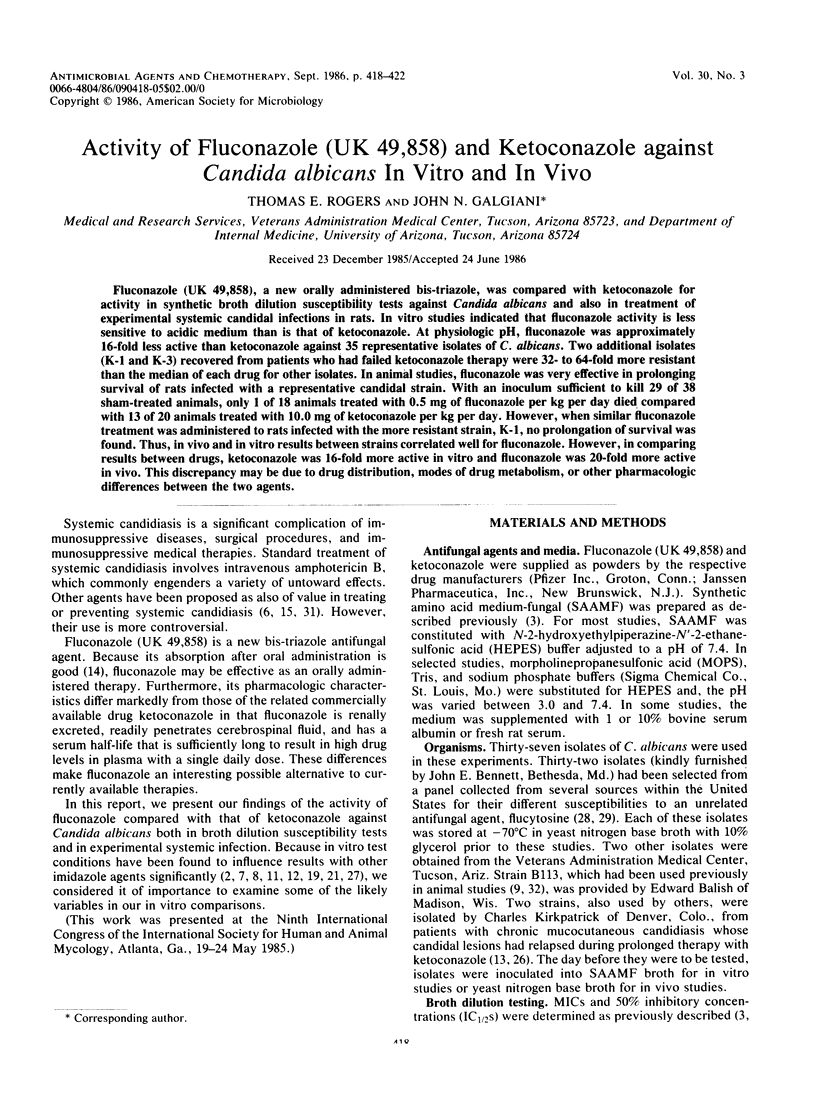
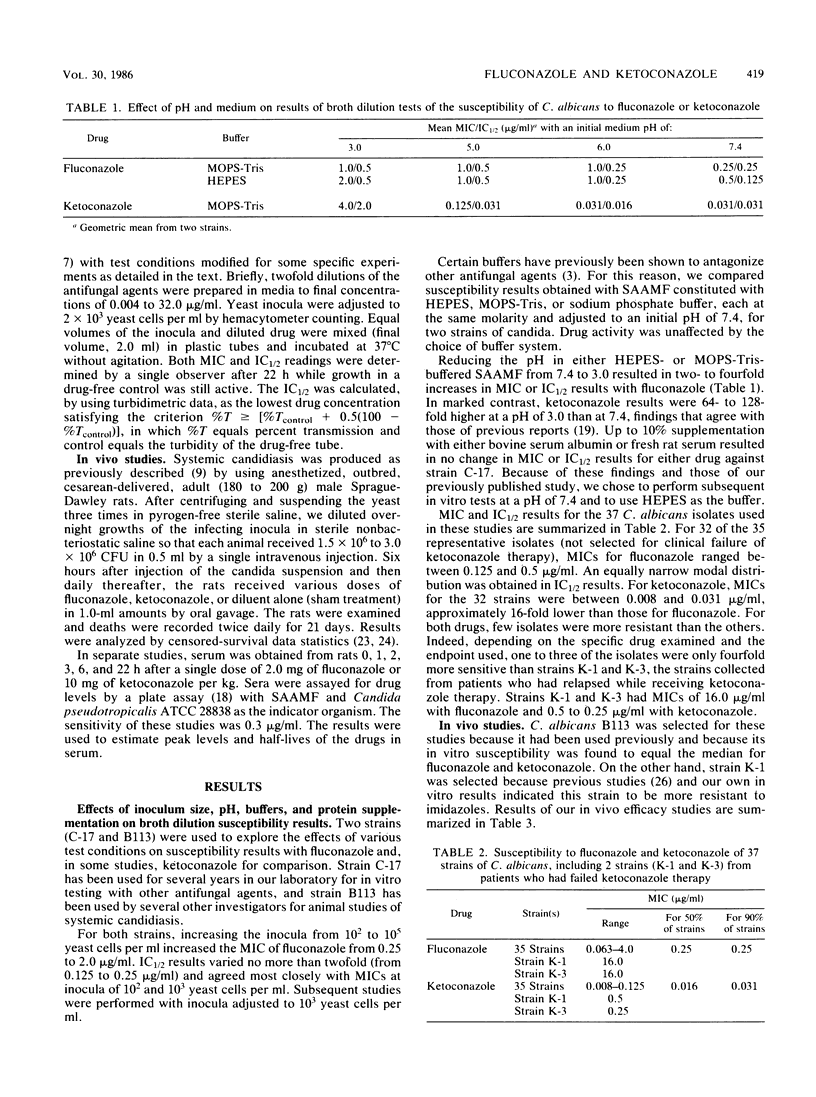
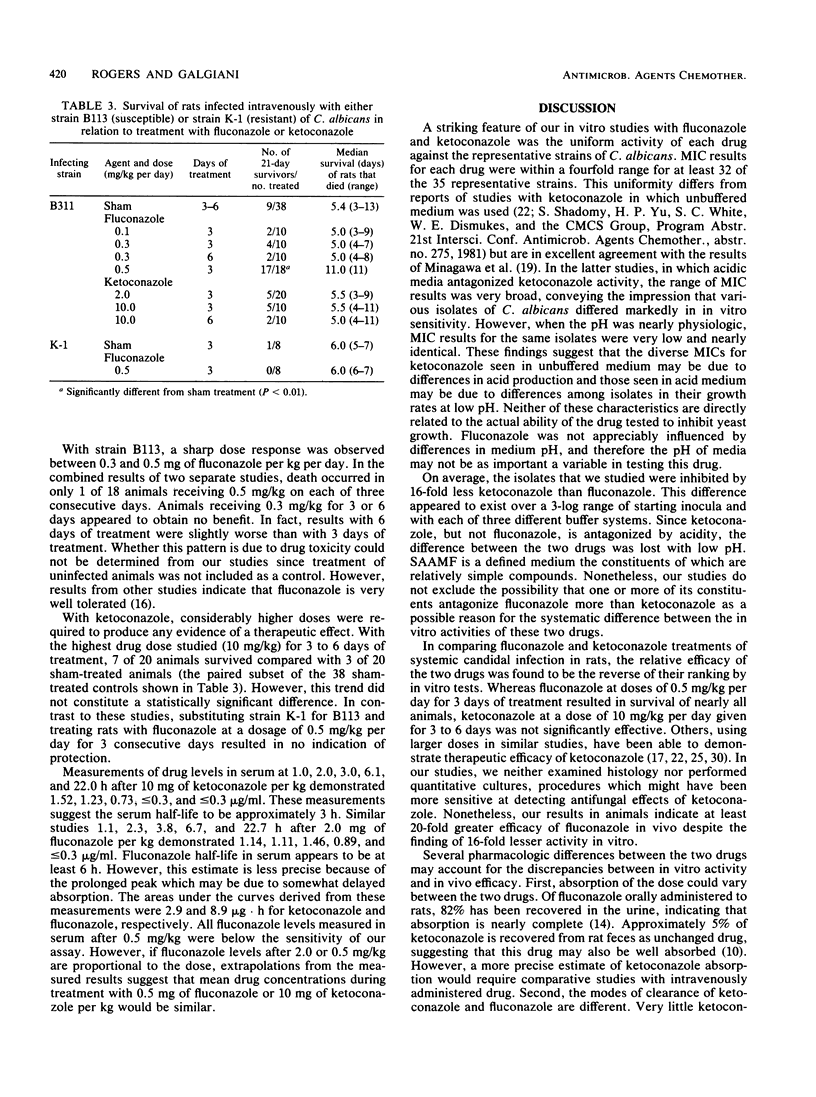
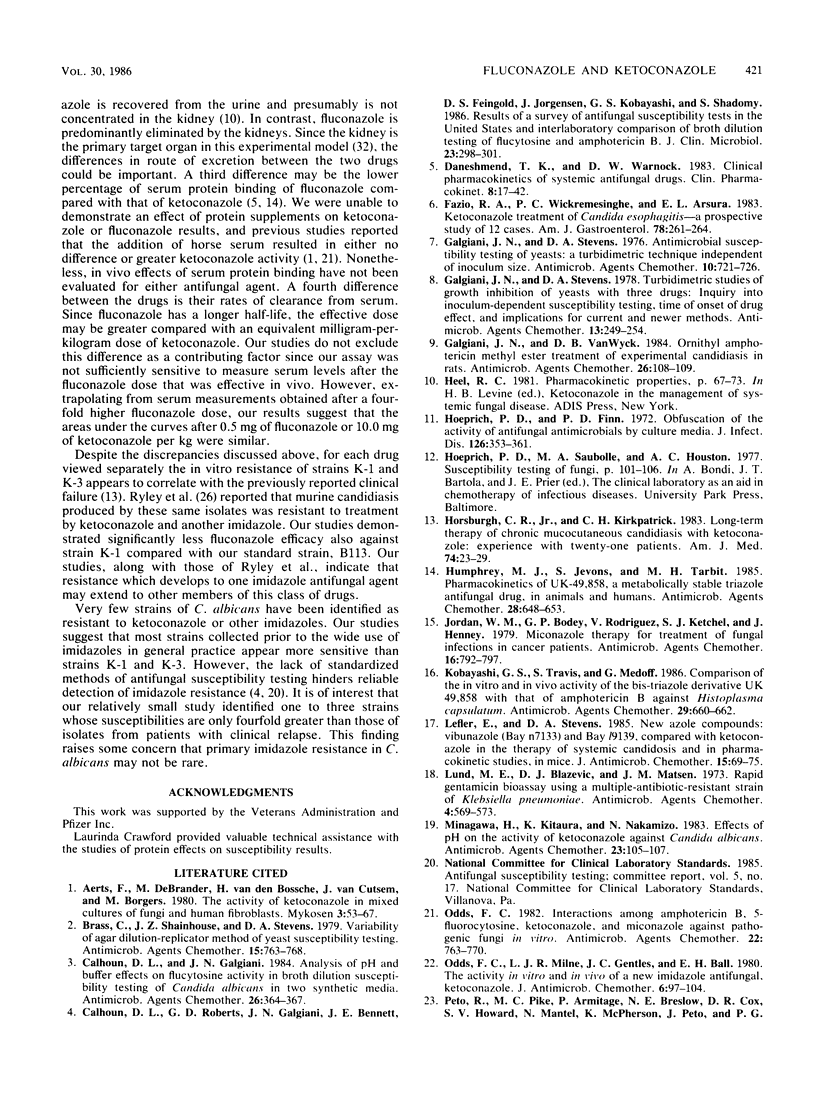
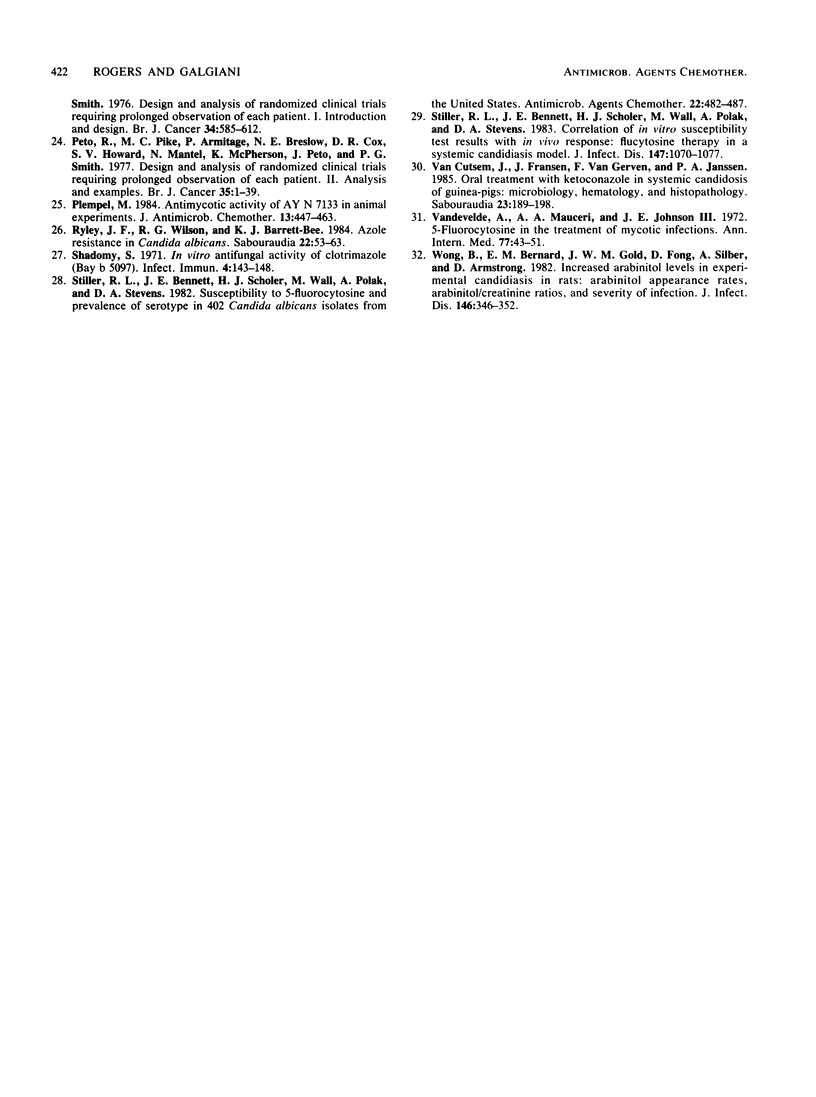
Selected References
These references are in PubMed. This may not be the complete list of references from this article.
- Aerts F., De Brabander M., van den Bossche H., van Cutsem J., Borgers M. The activity of ketoconazole in mixed cultures of fungi and human fibroblasts. Mykosen. 1980 Feb;23(2):53–67. doi: 10.1111/j.1439-0507.1980.tb02581.x. [DOI] [PubMed] [Google Scholar]
- Brass C., Shainhouse J. Z., Stevens D. A. Variability of agar dilution-replicator method of yeast susceptibility testing. Antimicrob Agents Chemother. 1979 Jun;15(6):763–768. doi: 10.1128/aac.15.6.763. [DOI] [PMC free article] [PubMed] [Google Scholar]
- Calhoun D. L., Galgiani J. N. Analysis of pH and buffer effects on flucytosine activity in broth dilution susceptibility testing of Candida albicans in two synthetic media. Antimicrob Agents Chemother. 1984 Sep;26(3):364–367. doi: 10.1128/aac.26.3.364. [DOI] [PMC free article] [PubMed] [Google Scholar]
- Calhoun D. L., Roberts G. D., Galgiani J. N., Bennett J. E., Feingold D. S., Jorgensen J., Kobayashi G. S., Shadomy S. Results of a survey of antifungal susceptibility tests in the United States and interlaboratory comparison of broth dilution testing of flucytosine and amphotericin B. J Clin Microbiol. 1986 Feb;23(2):298–301. doi: 10.1128/jcm.23.2.298-301.1986. [DOI] [PMC free article] [PubMed] [Google Scholar]
- Daneshmend T. K., Warnock D. W. Clinical pharmacokinetics of systemic antifungal drugs. Clin Pharmacokinet. 1983 Jan-Feb;8(1):17–42. doi: 10.2165/00003088-198308010-00002. [DOI] [PubMed] [Google Scholar]
- Fazio R. A., Wickremesinghe P. C., Arsura E. L. Ketoconazole treatment of Candida esophagitis--a prospective study of 12 cases. Am J Gastroenterol. 1983 May;78(5):261–264. [PubMed] [Google Scholar]
- Galgiani J. N., Stevens D. A. Antimicrobial susceptibility testing of yeasts: a turbidimetric technique independent of inoculum size. Antimicrob Agents Chemother. 1976 Oct;10(4):721–728. doi: 10.1128/aac.10.4.721. [DOI] [PMC free article] [PubMed] [Google Scholar]
- Galgiani J. N., VanWyck D. B. Ornithyl amphotericin methyl ester treatment of experimental candidiasis in rats. Antimicrob Agents Chemother. 1984 Jul;26(1):108–109. doi: 10.1128/aac.26.1.108. [DOI] [PMC free article] [PubMed] [Google Scholar]
- Galgiant J. N., Stevens D. A. Turbidimetric studies of growth inhibition of yeasts with three drugs: inquiry into inoculum-dependent susceptibility testing, time of onset of drug effect, and implications for current and newer methods. Antimicrob Agents Chemother. 1978 Feb;13(2):249–254. doi: 10.1128/aac.13.2.249. [DOI] [PMC free article] [PubMed] [Google Scholar]
- Hoeprich P. D., Finn P. D. Obfuscation of the activity of antifungal antimicrobics by culture media. J Infect Dis. 1972 Oct;126(4):353–361. doi: 10.1093/infdis/126.4.353. [DOI] [PubMed] [Google Scholar]
- Horsburgh C. R., Jr, Kirkpatrick C. H. Long-term therapy of chronic mucocutaneous candidiasis with ketoconazole: experience with twenty-one patients. Am J Med. 1983 Jan 24;74(1B):23–29. doi: 10.1016/0002-9343(83)90511-9. [DOI] [PubMed] [Google Scholar]
- Humphrey M. J., Jevons S., Tarbit M. H. Pharmacokinetic evaluation of UK-49,858, a metabolically stable triazole antifungal drug, in animals and humans. Antimicrob Agents Chemother. 1985 Nov;28(5):648–653. doi: 10.1128/aac.28.5.648. [DOI] [PMC free article] [PubMed] [Google Scholar]
- Jordan W. M., Bodey G. P., Rodriguez V., Ketchel S. J., Henney J. Miconazole therapy for treatment of fungal infections in cancer patients. Antimicrob Agents Chemother. 1979 Dec;16(6):792–797. doi: 10.1128/aac.16.6.792. [DOI] [PMC free article] [PubMed] [Google Scholar]
- Kobayashi G. S., Travis S., Medoff G. Comparison of the in vitro and in vivo activity of the bis-triazole derivative UK 49,858 with that of amphotericin B against Histoplasma capsulatum. Antimicrob Agents Chemother. 1986 Apr;29(4):660–662. doi: 10.1128/aac.29.4.660. [DOI] [PMC free article] [PubMed] [Google Scholar]
- Lefler E., Stevens D. A. New azole compounds: vibunazole (Bay n7133) and Bay L9139, compared with ketoconazole in the therapy of systemic candidosis and in pharmacokinetic studies, in mice. J Antimicrob Chemother. 1985 Jan;15(1):69–75. doi: 10.1093/jac/15.1.69. [DOI] [PubMed] [Google Scholar]
- Lund M. E., Blazevic D. J., Matsen J. M. Rapid gentamicin bioassay using a multiple-antibiotic-resistant strain of Klebsiella pneumoniae. Antimicrob Agents Chemother. 1973 Nov;4(5):569–573. doi: 10.1128/aac.4.5.569. [DOI] [PMC free article] [PubMed] [Google Scholar]
- Minagawa H., Kitaura K., Nakamizo N. Effects of pH on the activity of ketoconazole against Candida albicans. Antimicrob Agents Chemother. 1983 Jan;23(1):105–107. doi: 10.1128/aac.23.1.105. [DOI] [PMC free article] [PubMed] [Google Scholar]
- Odds F. C. Interactions among amphotericin B, 5-fluorocytosine, ketoconazole, and miconazole against pathogenic fungi in vitro. Antimicrob Agents Chemother. 1982 Nov;22(5):763–770. doi: 10.1128/aac.22.5.763. [DOI] [PMC free article] [PubMed] [Google Scholar]
- Odds F. C., Milne L. J., Gentles J. C., Ball E. H. The activity in vitro and in vivo of a new imidazole antifungal, ketoconazole. J Antimicrob Chemother. 1980 Jan;6(1):97–104. doi: 10.1093/jac/6.1.97. [DOI] [PubMed] [Google Scholar]
- Peto R., Pike M. C., Armitage P., Breslow N. E., Cox D. R., Howard S. V., Mantel N., McPherson K., Peto J., Smith P. G. Design and analysis of randomized clinical trials requiring prolonged observation of each patient. II. analysis and examples. Br J Cancer. 1977 Jan;35(1):1–39. doi: 10.1038/bjc.1977.1. [DOI] [PMC free article] [PubMed] [Google Scholar]
- Plempel M. Antimycotic activity of BAY N 7133 in animal experiments. J Antimicrob Chemother. 1984 May;13(5):447–463. doi: 10.1093/jac/13.5.447. [DOI] [PubMed] [Google Scholar]
- Ryley J. F., Wilson R. G., Barrett-Bee K. J. Azole resistance in Candida albicans. Sabouraudia. 1984;22(1):53–63. [PubMed] [Google Scholar]
- Shadomy S. In vitro antifungal activity of clotrimazole (Bay b 5097). Infect Immun. 1971 Aug;4(2):143–148. doi: 10.1128/iai.4.2.143-148.1971. [DOI] [PMC free article] [PubMed] [Google Scholar]
- Stiller R. L., Bennett J. E., Scholer H. J., Wall M., Polak A., Stevens D. A. Correlation of in vitro susceptibility test results with in vivo response: flucytosine therapy in a systemic candidiasis model. J Infect Dis. 1983 Jun;147(6):1070–1077. doi: 10.1093/infdis/147.6.1070. [DOI] [PubMed] [Google Scholar]
- Stiller R. L., Bennett J. E., Scholer H. J., Wall M., Polak A., Stevens D. A. Susceptibility to 5-fluorocytosine and prevalence of serotype in 402 Candida albicans isolates from the United States. Antimicrob Agents Chemother. 1982 Sep;22(3):482–487. doi: 10.1128/aac.22.3.482. [DOI] [PMC free article] [PubMed] [Google Scholar]
- Van Cutsem J., Fransen J., Van Gerven F., Janssen P. A. Oral treatment with ketoconazole in systemic candidosis of guinea-pigs: microbiology, hematology and histopathology. Sabouraudia. 1985 Jun;23(3):189–198. doi: 10.1080/00362178585380291. [DOI] [PubMed] [Google Scholar]
- Vandevelde A. G., Mauceri A. A., Johnson J. E., 3rd 5-fluorocytosine in the treatment of mycotic infections. Ann Intern Med. 1972 Jul;77(1):43–51. doi: 10.7326/0003-4819-77-1-43. [DOI] [PubMed] [Google Scholar]
- Wong B., Bernard E. M., Gold J. W., Fong D., Silber A., Armstrong D. Increased arabinitol levels in experimental candidiasis in rats: arabinitol appearance rates, arabinitol/creatinine ratios, and severity of infection. J Infect Dis. 1982 Sep;146(3):346–352. doi: 10.1093/infdis/146.3.346. [DOI] [PubMed] [Google Scholar]


